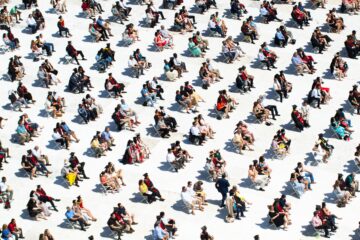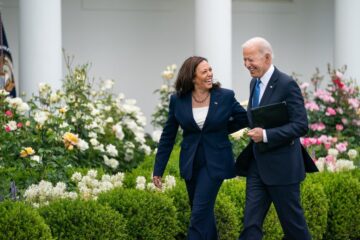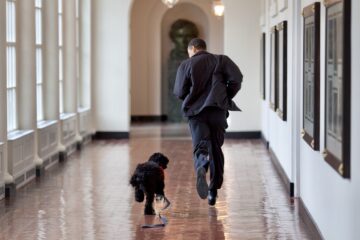Welcome back to Week 9 in my weekly reports analyzing the Covid-19 pandemic and its effects on the country, higher education and study abroad. For those of you reading this on my blog, Off the Silk Road, I have also launched a newsletter, where these reports can be sent directly to your email each week. Click here to subscribe.
Last week, I examined the potential effects of the protests on viral transmission, as well as discussed models for the fall and college students’ feedback. This week, we will re-evaluate the state of higher education for the fall and discuss greater national trends. Once again, we will be focusing this week’s report on three major topics: a national view, higher education and study abroad.
There’s a lot of material to go through (as per usual), so let’s get straight to it.
A national look
In many ways, the great American experiment of reopening has failed. New cases per day are still pegged at around 20,000 and deaths are stagnant at 900 per day. We have become numb to the fact that close to 1,000 Americans will lose their lives to this virus every day. The CDC has now predicted over 130,000 deaths by July 4 and the IHME model, frequently cited by the White House, has raised its death toll projection to 145,278 deaths by August 4, up from 140,496 on June 5. The new modeling shows uptick in mobility, as well as estimates of self-reported mask use and trends in pneumonia illnesses.
This is not the beginning of the second wave. It’s only the middle of the first. Dr. Ashish Jha, the director of the Harvard Global Health Institute, basing his estimates on recent death rates, anticipates another 100,000 deaths by September. “We are the only country in the world that opened up without our cases getting it down to where we need it to,” he said.
(Somewhat) good news: despite the absence of a national testing strategy, testing continues to increase. It’s not at the level we need it, where everyone who wants a test nationwide can get one, but increased testing has helped drive the test positivity rate down in some areas of the country. However, in many other places, the test positivity rate remains stagnant. In Miami, an 8% testing increase has led to a 42% increase in cases. This is alarming. With more testing, one would expect that surveillance of the disease would be on a wider population, many of whom will not have the disease. However, we are still detecting many cases of community spread. Former CDC director Dr. Tom Frieden encourages “armchair epidemiologists” to go beyond the simple numbers of cases and deaths and focus on unlinked infections and trends in excess mortality. Another important metric is hospitalizations, which are up in states including Utah, Arizona and Arkansas. With the pandemic shifting between regions of the country, and President Trump getting back to business as usual, it has become abundantly clear that we will be living with this disease for many months. In one of their nightly briefings, The New York Times wrote that “Instead of ordering people inside, governments have decided to reopen and accept a greater amount of illness and death.” This is regrettably the case in the United States. The rapid imposition of social distancing measures seen in March will never happen nationwide for a second time. This virus will continue to be “a leaky bucket,” according to the Michael Osterholm, the director of the Center for Infectious Disease Research and Policy (CIDRAP) at the University of Minnesota. The key now lies in early detection to “box it in.”

Let’s discuss the effects that the protests could have on viral transmission. While the increase in hospitalizations can currently be attributed to Memorial Day activities and states opening too early, protests in 1,280 places all over the country can accelerate the spread in multiple ways: respiratory droplets by protestors, coughing due to tear gas and close quarters in police stations where those are arrested. Trevor Bedford, an expert on the virus at the Fred Hutchinson Cancer Research Institute, wrote on Twitter that each day of protests could result in about 3,000 new cases and 50 to 500 deaths.
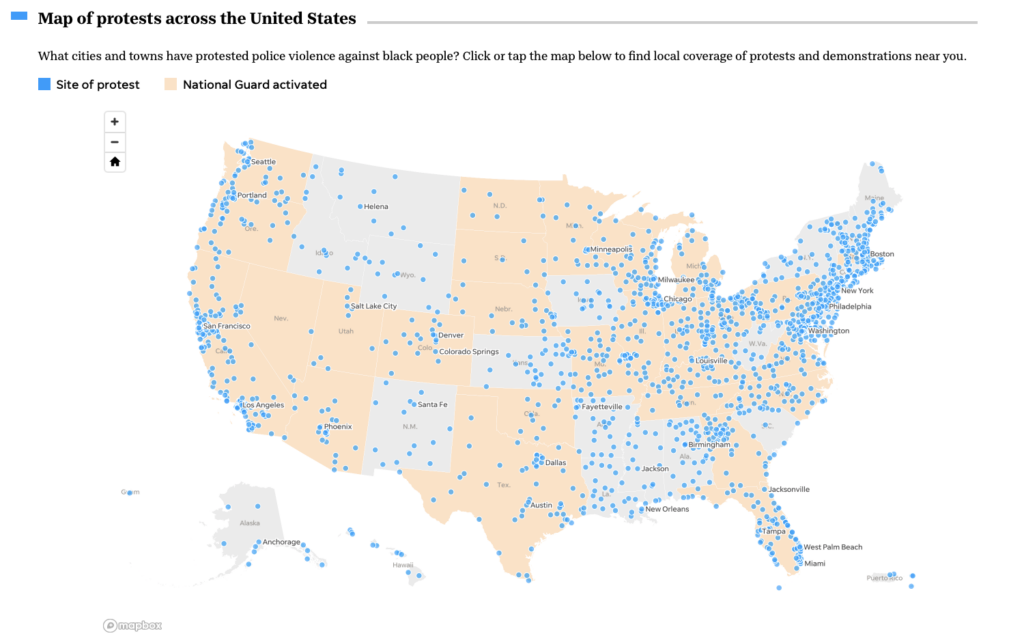
Around the world, countries such as Iceland and New Zealand have been lauded for their coronavirus response, with New Zelalanders essentially returning to life as normal. The virus is spreading like wildfire in the U.S., and the fire department is stuck in New Zealand. The White House has thrown in the towel and accepted defeat, and America has given up.
Vaccines may be ready for emergency use by the fall, says top Chinese virus specialist Zhong Nanshan, though use for the public is still a long ways away. According to Dr. Anthony Fauci, the rising cases are “disturbing. If you leapfrog over certain phrases you risk having a resurgence,” he told CNN’s Wolf Blitzer. Late this week, IHME updated its model to show a more pronounced increase during September, right around the time students are scheduled to return to school. National production of PPE is not ready for a surge.
A kerfuffle emerged towards the beginning of the week, where the World Health Organization failed to denote the difference between “asymptomatic” (never showing symptoms) and “pre-symptomatic” (being infected, but will show symptoms at some point). The bottom line is you can be infectious if you don’t show symptoms. We don’t know enough about truly asymptomatic cases, since those are incredibly hard to trace. We really don’t know much about anything when it comes to this virus, relatively speaking.
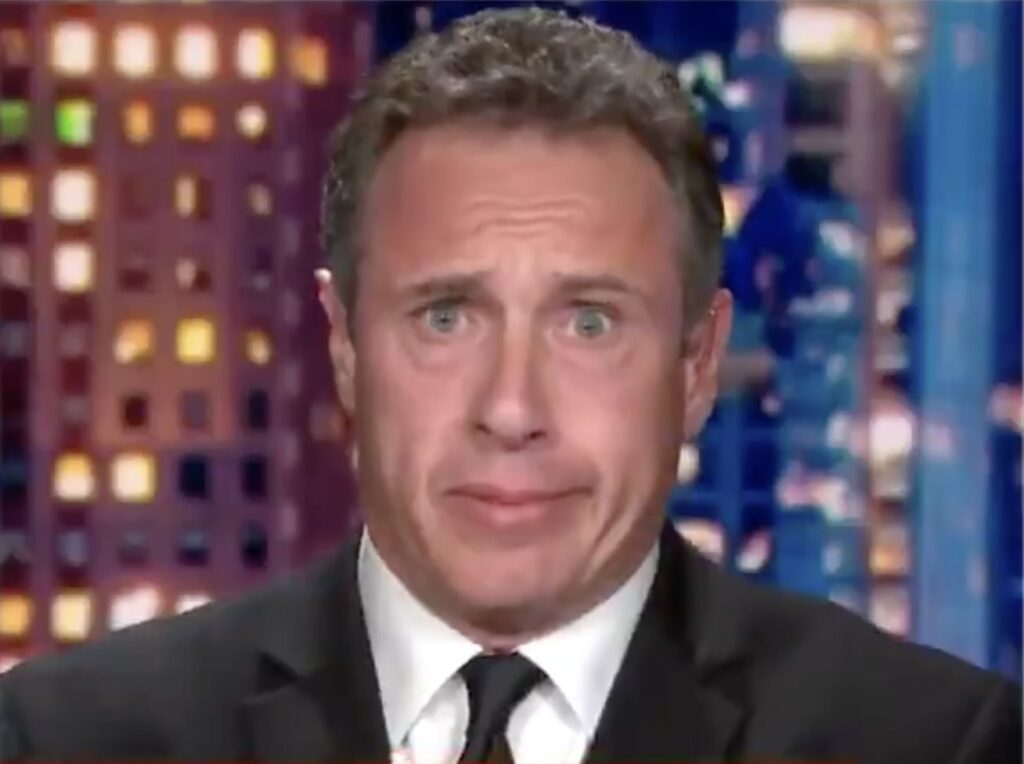
There still exists a striking racial disparity in Covid-19 cases and deaths. In Vermont, where 94% of the population is white, Black Vermonters are 7 times as likely to test positive for Covid-19 than white Vermonters, while this racial disparity has only been growing over time as more cases are confirmed.


I would estimate that I read over 200 articles per week on the coronavirus. It is impossible for me to summarize every detail that comes across my desk each week. There are many pieces of news that do not make it into each week’s report. Here I’ll try to briefly outline some of the new pieces of information now available.
- As more people begin to feel comfortable extending their social distancing “bubble,” using a social network approach could help mitigate viral spread.
- Regeneron has started trials of an antibody “cocktail,” that could help treat patients with different severities of symptoms.
- An outbreak has occurred in Maine at an Abbott factory, which ironically produces coronavirus tests.
- 44% of 511 epidemiologists surveyed by The New York Times anticipate that they would wait 3-12 months to travel by airplane.
- Testing is still cost-prohibitive — my colleague Jake Gaughan at The Middlebury Campus attended a protest in Hawaii and since he did not display symptoms, he had to pay $130 out-of pocket.
- The county supervisor in Orange County, California has announced face coverings are no longer required.
- A metric tracker developed by Senate Republicans has determined that no state is ready to reopen.
- An observational study conducted in Wisconsin grocery stores showed that 41.2% used face coverings.
- Masks work — two hairstylists in Missouri who had coronavirus and wore masks saw 140 clients and no new infections have been linked to the salon.
- A CDC poll showed that U.S. adults widely approved of measures to slow the virus’ spread.
- A study from epidemiologists at Imperial College London estimated the shutdowns saved about 3.1 million lives in 11 European countries.
- Shutdown orders prevented about 60 million novel coronavirus infections in the United States and 285 million in China, according to a research study.
- A CDC study from the USS Theodore Roosevelt showed that young, healthy adults with Covid-19 might have mild or no symptoms, but loss of taste and smell is common.
- A young woman in her 20s received a double lung transplant after being infected with the coronavirus.
I wanted to offer one case study from Winooski, Vermont, that shows us how volatile the situation can be. Vermont, a state known for its relative success in containing the virus, has seen an outbreak in a dense city with 81 cases, many connected to one family. 80% were asymptomatic at the time of testing, and many were young children. Why is this significant? Simple. This is a similar situation to a college campus, with many young individuals, and should serve as a cautionary tale.
While we are on the topic of colleges, I found this story from a University of Vermont basketball game to be particularly striking. On March 10, more than 3,200 people crowded into a gym in Vermont to watch a basketball game. At least 16 Vermonters who attended the game experienced symptoms, and three of them have died of the virus. Mapping by my colleague Erin Petenko shows that many were seated in the same area.

We must assume that this virus can be transmitted in an airborne manner. A study using New York City as an example showed that wearing of face masks in public corresponds to the most effective means to prevent interhuman transmission.
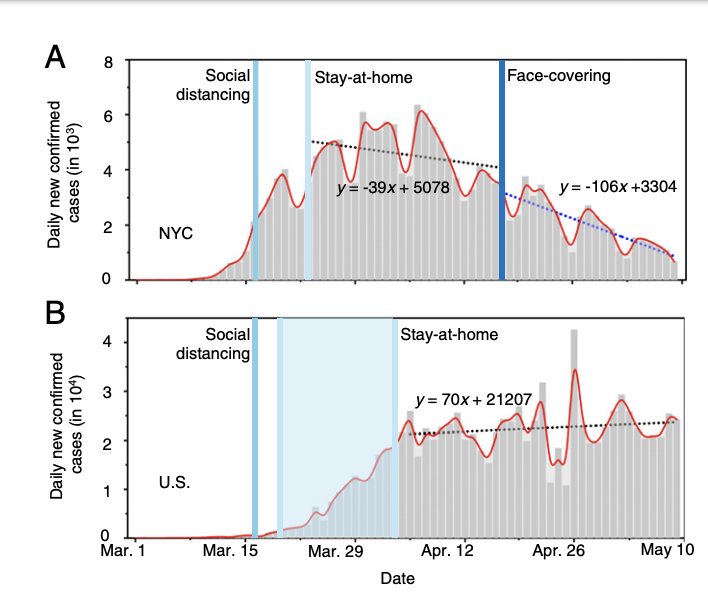
I have always said that public health should never be political. It is baffling to me the wide discrepancy between Democrats and Republicans when it comes to certain aspects of the virus, according to a new CNN poll.
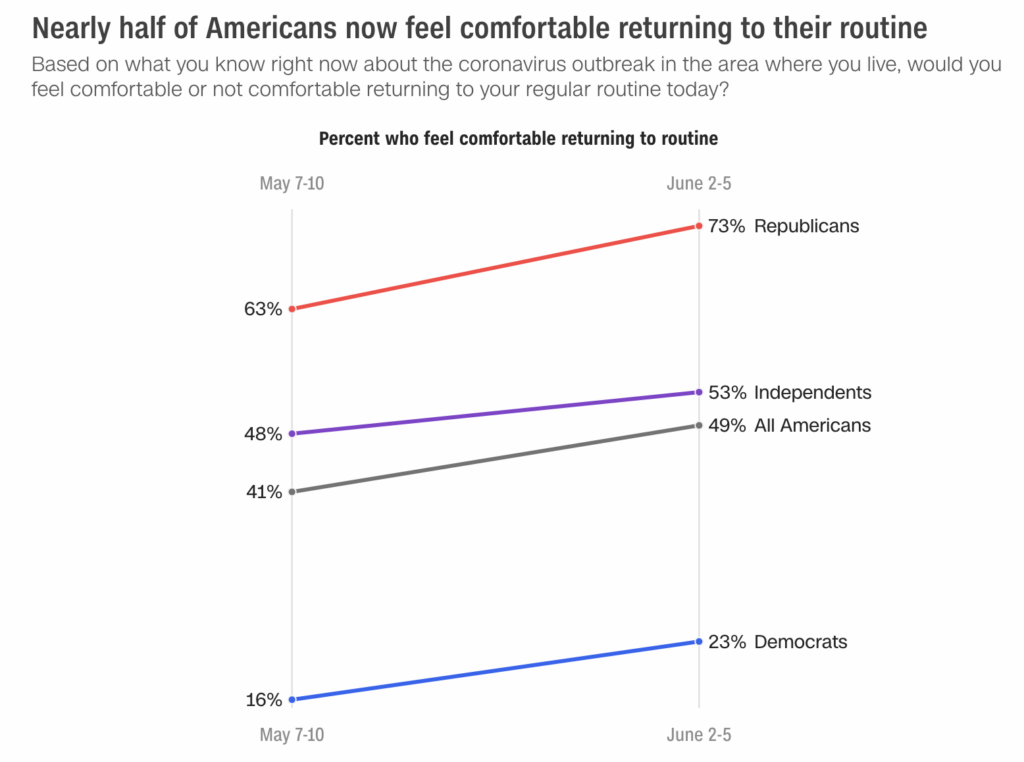
Having laid down the groundwork on the national scene, let’s take a look at the latest developments in higher ed.
Higher education
As we approach the end of June, when many colleges and universities said they would release fall plans, it is becoming abundantly clear that the opening on-campus fall train is too heavy to stop now. For many schools, it is now no longer a question of if they will reopen, but when and how. Here are the two primary factors that are driving reopening:
- Remote learning is incredibly unpopular among students, as seen from surveys at Colorado College, Amherst, Bowdoin, Middlebury and Williams, among others.
- Colleges face absurdly large financial pressures if they are remote in the fall.
Like news pieces on the coronavirus, I read around 100 plans from colleges each week on reopening, as reported by a slew of student newspapers. Many models are now incredibly similar. Rather than focus on these particular schools’ plans, I will focus on aspects of these plans that are shared across the board. At the end of the day, it doesn’t matter what an individual school chooses. It’s all about the aggregate.
Let’s talk about testing and tracing. As Nell Gluckman reports in The Chronicle of Higher Education, testing and contact tracing will be key. The community buying into a contact tracing program (whether manually or through an app) will be necessary. The current polymerase chain reaction (PCR) tests are currently too expensive and take too long to process to realistically deploy on a large scale, in my opinion. The availability of antigen tests, of which one has been approved by the FDA under an emergency use authorization, will be key for colleges’ testing plans. PCR tests can cost up to $50 and take a few days to process. Antigen tests (using saliva) could cost as little as $5 and can take minutes to process. I’ve created this model so you can estimate how much it would cost to deploy PCR tests across your institution.
There are two main ways to test large groups of people: as individuals and in pools. Pooled testing involves combining students in groups and testing samples. Students in any pool that test positive will take a second Covid-19 test to determine whether they have the virus. Syracuse University anticipates using this model. A key question that remains unanswered in my mind is how colleges will deal with students during the period it takes to get their results back. In an antigen test case, this could be easy. However, if test results take days, there has been little mention, with the exception of the University of Connecticut, of how this quarantine would work.
One interesting method Syracuse University is employing is monitoring sewage to detect coronavirus infection. Research has shown that the virus is detected in fecal matter, often before a patient shows symptoms. If this is true, this could be innovative.
Let’s take this moment to revisit models I proposed on May 8, showing 10 options for colleges in the fall.
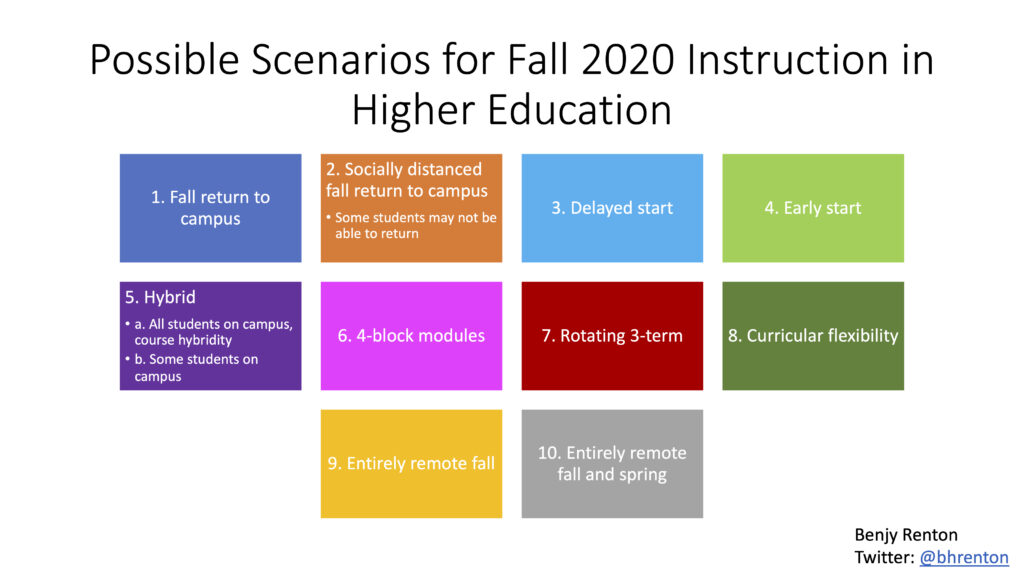
Currently, we are seeing a combination of models 2-9, with 2-6 being the most common.
Fall plans depend on two major concepts: resources and behavior. Let’s first talk about resources.
Opening is expensive. Between testing to disinfectants to signs, it is impossible to quantify the costs it will take for colleges to open in the fall. An anonymous respondent in a Chronicle survey compared planning amid Covid-19 to “nailing Jell-O to the wall.”
Just take a look at all the measures colleges are considering.
Purdue University is raising money from their donors to pay for plexiglass shields. Duke University and Boston University are paying for hotels to house some students. Boston University is also selling masks in their bookstore. Niagara University is even paying for virus-blocking pillows (whatever that means). In colleges’ minds, all these costs are worth bringing students back, since an all-remote semester is too costly.
However, there is also a human cost. Colleges are asking federal governments for legal protections if outbreaks occur. “If liability is on your mind, you probably shouldn’t be open as broadly as you are,” José Luis Cruiz, Provost of The City University of New York (CUNY), said in a Chronicle webinar. For more on the student perspective, I’d recommend you check out this letter written by a Yale student on her concerns. She raises important points, including the opinion that colleges need to address students staying healthy, students missing class and sick professors. “[Johns Hopkins] might not consider the fact that their students might still be recovering long after isolation,” one Johns Hopkins University student who has recovered from the virus said, noting that isolation takes an incredible toll on students’ mental health.
At the same time that the student perspective must be heard, the faculty voice is equally vital. “Are you asking for my preferences because you want to honor them? Or … because you want to see how much I’m willing to put myself at risk for Covid?” one faculty member told the Chronicle. Higher ed professor at UNC Wilmington Kevin McClure observed colleges’ Covid-19 task forces and stressed the need for faculty members and medical experts who would be willing to challenges administrators’ decisions.
Colleges are incredibly dense places, many denser than some cities. This allows infection to spread easily. Reducing density in classrooms and residential spaces will be key, as seen in the University of Massachusetts’ plan. Using a cohort approach and a staggered move-in could help as well. Syracuse University has created alternating days for students to attend classes. (It’s worth nothing that I have not seen too many mentions on how temperature checks will work, if colleges choose to employ them.) It will be interesting to watch this housing tracker from the Association of College and University Housing Officers – International to see how colleges decide to fill spaces in dorms and set aside certain buildings for quarantine and isolation.
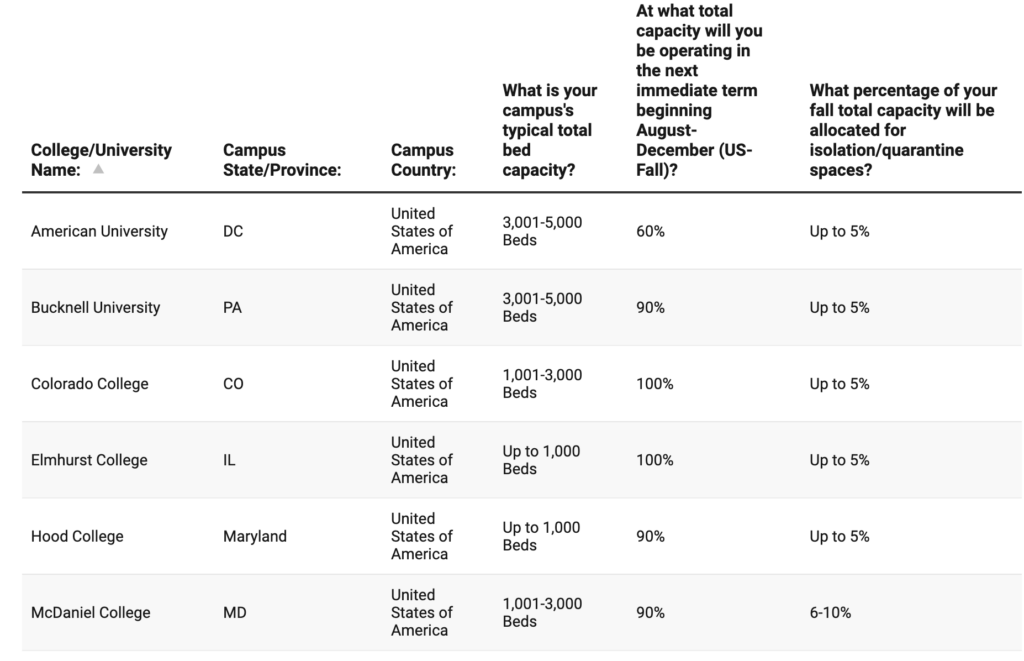
An alphabet soup of acronyms is in charge of figuring out how colleges will conduct classes. Throughout many schools, a flexible learning model is emerging. This will ensure that all students can attend classes from anywhere, including in the classroom, in their dorm room (if they are in isolation or are alternating class days) or at home (for those who will not return to campus, especially those with disabilities). I suggest you check out Northeastern University’s NUFlex model for a detailed description. Outfitting classrooms with the equipment to livestream and record will be expensive.
One can analyze colleges’ decisions by many factors, including selectivity, size, endowment and politics. I would also add one more: local K-12 schools. Two weeks ago, my colleague Jake and I presented some of our findings along these variables. This week, the Chronicle used many of the same techniques to show that reopening may have become a partisan issue.
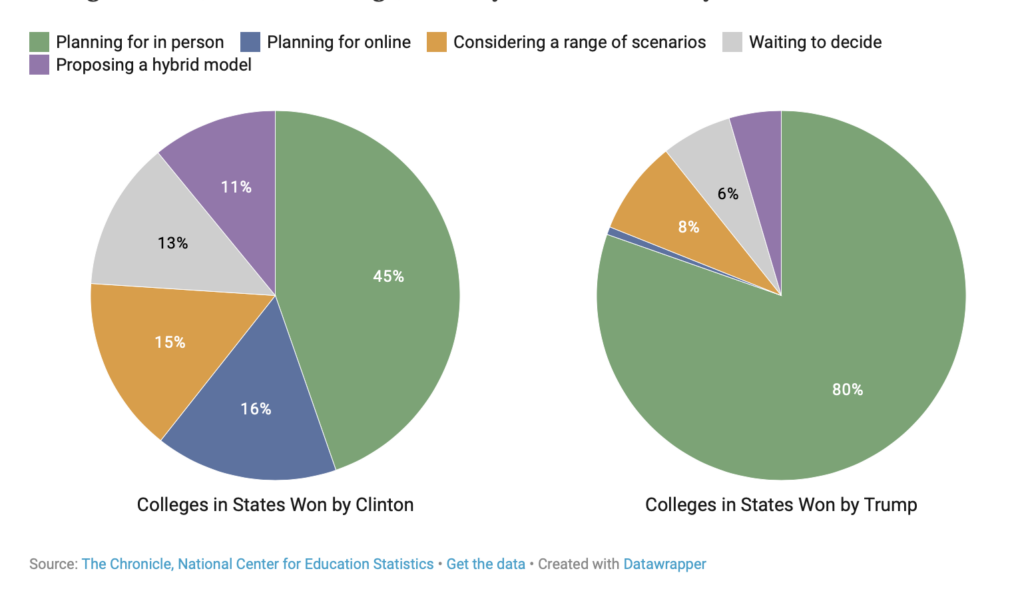
While we are on the topic of K-12 schools, I wanted to share this new research from China “that found that while children were roughly a third as likely to contract coronavirus in comparison to adults, going to school gave them three times as many chances to become infected, effectively making children just as much at risk as adults,” as reported by Annie Grayer in a CNN article. “While proactive school closures cannot interrupt transmission on their own, they can reduce peak incidence by 40-60% and delay the epidemic,” the study found.
Now that we have talked about resources, let’s briefly explore behavior. Since we all cannot use Zorb balls to permanently socially distance each other, many colleges have discussed having students sign some form of a “behavior pledge,” where students promise to follow social distancing measures. I really don’t know if this will work — this remains an open question. Enforcement is also an issue that will need to be addressed. We’ll see how this is discussed in the coming weeks.
We’ve heard a lot of notices from colleges announcing plans to open in person. The New York Times Magazine published a long-form piece on what the fall is expected to be like. Let’s take a look at some online announcements. In an email to undergraduate faculty, Harvard University’s dean of undergraduate education wrote that “it seems likely that, under any scenario, most of our instruction will be online.” This will be a key school to watch. Southern New Hampshire University (SNHU) announced its decision to extend remote learning for campus students through the Fall 2020 semester. St. Thomas University in New Brunswick, Canada has also gone online for the fall. Canada will be an interesting place to watch in terms of higher ed.
As the NCAA Division III Administrative Committee has extended the sports preseason to start on August 10, and as many Division I schools have already brought fall athletes back, we have noticed an uptick in imported cases, many asymptomatic, as colleges test athletes. I’ve included reports of these schools in this map, which will continuously be updated as I receive new reports. It is worth noting that I added the 15 positive tests of cadets at West Point, where President Trump is scheduled to give the commencement address today. While not athletes, I still think they are important to consider.
One important aspect of colleges’ plans that needs to be developed more is if and when they decided to send students home in the case of an outbreak. We have learned from the spring that a rapid evacuation is incredibly challenging. We also know that in the case of outbreaks, it may be worth isolating students on campus so they do not transmit the virus back to their home communities.
I would like to finish today’s discussion with the results of this new modeling study done by professors Philip T. Gressman and Jennifer R. Peck on simulating Covid-19 in a university environment. The authors use certain interventions, such as moving large classes online and wearing face masks, to determine which are most effective in slowing the spread. They found that allowing in-person meetings of large classes increases infections from 43 to 538 in the median simulation run. Key findings also include:
- Testing accuracy is a critical issue which needs immediate attention.
- Holding large classes greatly increases the risk of a significant outbreak on campus.
- It is extremely important that students refrain from all contact outside of academic and residential settings.
- All instructors need to prepare for extended student absences due to quarantine (In their best-case scenario, students spend an average of 1-2 weeks of the semester with at least 10% of their classmates absent due to quarantine)
Yesterday, Beijing reported two new locally transmitted cases, the first in 55 days, and delayed its back-to-school plans. It baffles me that in the U.S., despite seeing 20,000 cases per day, we think that we can seamlessly bring students back to school, both K-12 and higher education. Only time will tell how this will play out. At the moment, it looks like the majority of students will see a fall semester on campus, albeit with certain protective measures. Colleges are going to continue to do whatever they can to bring students back. Whether this will be carried out successfully remains an open question — and the second great American experiment.
Study abroad and international travel
I still don’t think study abroad programs will be running for the fall. This week, Penn State and Stanford University announced fall program suspensions. The risk of flying, immigration and airline policies all remain factors for both study abroad programs and international students.
The Good Stuff
Let’s roll the clips of the good stuff. In my weekly tradition, I feature my favorite pieces from the week, including great examples of student journalism. There were a lot to choose from this week, so let’s go with the top 10.
- On the two-year anniversary of Anthony Bourdain’s passing, we remember the way he once described the Waffle House. “It is indeed marvelous. An irony-free zone where everything is beautiful and nothing hurts.”
- One high school newspaper in Maryland interviews Dr. Anthony Fauci.
- The Sikh community helps feed the people of New York.
- Duke University student journalists recall the day they were sent home.
- Margot Armbruster and Taylor Plett, two students at Duke, bake an apple crisp with their political science professor before the coronavirus hit.
- Linguists say that saying “vous,” not “tu,” in French could limit virus spread due to the word’s pronunciation.
- One developer tries to illustrate 100,000 lives lost through 100,000 computer-generated faces.
- One island in Maine has been sheepherding for centuries.
- Vermont Public Radio host Jane Lindholm’s young son waves as his elementary school teachers pass by his house for an end-of-year ceremony.
- Canadian Prime Minister Justin Trudeau has not had a haircut for three months.
Conclusion
There you have it. Over 12 pages of source links distilled into this week’s coronavirus update. We will continue to see the effects of summer, reopening and the protests on viral spread. This is the great American experiment and our actions now can affect the future months. The virus is still spreading dangerously, even if it is no longer in the news every minute of the day.
In many areas where they can declare the pandemic as “controlled,” outbreaks continue to pop up. A cluster at a Hong Kong public housing estate (tight quarters, similar to colleges in terms of density) was discovered today. 45 workers at a Beijing wholesale food market have just tested positive for the coronavirus showing no symptoms, along with seven with symptoms.
I’d like to thank all the student journalists with whom I have the pleasure of working. In the next weeks and months, these student journalists will become ever more important in chronicling their colleges’ decisions for the fall and beyond. Support their work by reading it.
Finally, today is Saturday! CNN is hosting another Sesame Street Town Hall with all your favorite friends, including Elmo, Big Bird and Cadabby, and CNN’s Dr. Sanjay Gupta and Erica Hill.
“Like birds of a feather, we’re in this together, to help one another, to care for each other.”
— Benjy Renton (@bhrenton) June 13, 2020
C – Cover your face
A – Stay six feet apart
R – Remember to wash your hands
E – Everyone
Welcome to another #CNNSesameStreet Town Hall! pic.twitter.com/XfgClEUzj9
We must continue to follow the advice of experts and make sacrifices for the health of all us. My best to all for good health.
Like what you see? Don’t like what you see? Want to see more of something? Want to see less of something? Let me know in the comments. And don’t forget to subscribe to the weekly newsletter!
For more instant updates, follow me on Twitter @bhrenton.
